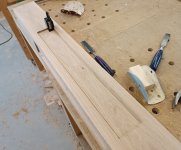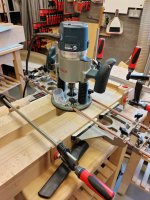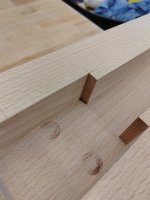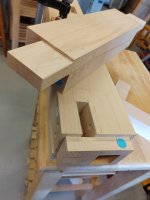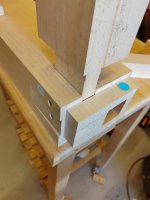Hi all. I posted for a while a good many years ago and have now re-joined.
This is written to request some feedback on the real world capability of Festool routers in deep plunge situations requiring high accuracy.
We have some Festool equipment (a Domino and an ancient but but excellent original TS 55 saw plus guide rails etc) but have to admit to having balked at the price of other stuff in the range.
I last evening however ran up against the limits of a lightly used (i.e. not worn) blue Bosch GMF 1400 (UK spec) plunge router when cutting a 45 wide x 39 deep x 400mm long parallel sided and flat bottomed slot in beech via multiple passes of about 5mm depth of cut using a 50mm cutting length x 19mm dia straight sided bit.
The Bosch performed acceptably on previous bearing guided profiling work, but proved very disappointing on this admittedly demanding application. (details below)
It's for replacement as there's number of scenarios coming up where high accuracy in deep plunges will be required. e.g. cutting deep mortises.
Festool is perhaps the obvious choice for a high end and hopefully precision router - people presumably pony up the premium price for more than bragging rights. It'd hurt badly though to pay out almost €1,000 for say a 1400EQ only to find that it wasn't much better - so hence this post.
Some experience based feedback of similar deep plunge precision work with this or a similar model would be appreciated. Also more generally on exactly what real world capabilities differentiate these routers from the mainstream.
The situation that developed with the Bosch was as follows:
It was set up with two fences on extra long mounting rails - with the fences bearing on the opposite and parallel sides of the work with the router in between. The fences were pushed in tight to the work (to the point where they were generating quite a lot of friction) - they definitely did not permit movement.
Despite this it turned out that when plunging the cutter was going perhaps 0.3mm deeper than the stop setting at the plunge point - so that its end was leaving a circular impression in the otherwise flat base of the slot. Put another way - when the plunge was locked it was lifting the cutter back up to the set height.
The cutter was also when plunging tipping out of vertical enough to very obviously mar the sides of the slot at the plunge points.
The body and cutter were also tilting enough to deliver an inconsistent depth of cut upon hitting the offset depth stop.
It likewise emerged that while the plunge was unlocked the cutter was being pulled about 0.3mm past the set line of cut by the cutting forces - enough to move it from one side of a pencil line to the other.
Examination showed that these inaccuracies were down to sloppy tolerances in the guide posts - that the cutter was moving around while plunging.
The assembly is pretty rigid once the plunge lock is done up (tight) but that's not much help while plunging as above.
A fixed base router clearly doesn't suffer from this problem, but it would be difficult and risky to cut this slot without plunge capability.
Thanks
This is written to request some feedback on the real world capability of Festool routers in deep plunge situations requiring high accuracy.
We have some Festool equipment (a Domino and an ancient but but excellent original TS 55 saw plus guide rails etc) but have to admit to having balked at the price of other stuff in the range.
I last evening however ran up against the limits of a lightly used (i.e. not worn) blue Bosch GMF 1400 (UK spec) plunge router when cutting a 45 wide x 39 deep x 400mm long parallel sided and flat bottomed slot in beech via multiple passes of about 5mm depth of cut using a 50mm cutting length x 19mm dia straight sided bit.
The Bosch performed acceptably on previous bearing guided profiling work, but proved very disappointing on this admittedly demanding application. (details below)
It's for replacement as there's number of scenarios coming up where high accuracy in deep plunges will be required. e.g. cutting deep mortises.
Festool is perhaps the obvious choice for a high end and hopefully precision router - people presumably pony up the premium price for more than bragging rights. It'd hurt badly though to pay out almost €1,000 for say a 1400EQ only to find that it wasn't much better - so hence this post.
Some experience based feedback of similar deep plunge precision work with this or a similar model would be appreciated. Also more generally on exactly what real world capabilities differentiate these routers from the mainstream.
The situation that developed with the Bosch was as follows:
It was set up with two fences on extra long mounting rails - with the fences bearing on the opposite and parallel sides of the work with the router in between. The fences were pushed in tight to the work (to the point where they were generating quite a lot of friction) - they definitely did not permit movement.
Despite this it turned out that when plunging the cutter was going perhaps 0.3mm deeper than the stop setting at the plunge point - so that its end was leaving a circular impression in the otherwise flat base of the slot. Put another way - when the plunge was locked it was lifting the cutter back up to the set height.
The cutter was also when plunging tipping out of vertical enough to very obviously mar the sides of the slot at the plunge points.
The body and cutter were also tilting enough to deliver an inconsistent depth of cut upon hitting the offset depth stop.
It likewise emerged that while the plunge was unlocked the cutter was being pulled about 0.3mm past the set line of cut by the cutting forces - enough to move it from one side of a pencil line to the other.
Examination showed that these inaccuracies were down to sloppy tolerances in the guide posts - that the cutter was moving around while plunging.
The assembly is pretty rigid once the plunge lock is done up (tight) but that's not much help while plunging as above.
A fixed base router clearly doesn't suffer from this problem, but it would be difficult and risky to cut this slot without plunge capability.
Thanks


